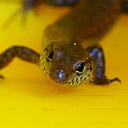Member-only story
Caught in the Act
A leaf from a builder’s book
The Briar Silky Oak (Musgravea heterophylla, Proteaceae) is growing well. It was only about a foot tall when I got it, but the summer heat and rain have given it a fillip. It is now three times taller, and each new leaf is 18 inches long. With its combination of colours — bright green, rust, and warm grey — and its sculptural shape, Musgravea is a spectacular plant.
But lately, it has been more sculptural and less spectacular.
A bee has taken a fancy to the sapling’s giant leaves and is visiting daily to snip off pieces to construct her nest tucked away in the timber.
Leafcutter bees (Megachile) are found in warmer areas worldwide. Megachile is a diverse genus with 1,500 species, of which about 150 occur in Australia. When I lived in Melbourne, Golden-tipped Leafcutter Bees (Megachile chrysopyga) were regulars in my tiny garden. These handsome black and white bees sported ginger tops and tails, and buzzed single-mindedly around the fan flowers (Scaevola aemula, Goodeniaceae). I don’t recall them wreaking havoc among the native plants at my place, but I’m sure they got stuck into the neighbours’ ornamentals.
Yesterday morning — in a rare moment of good timing — I was outside with the phone when a leafcutter flew in. I had seen the bee’s handiwork, but had yet to…
